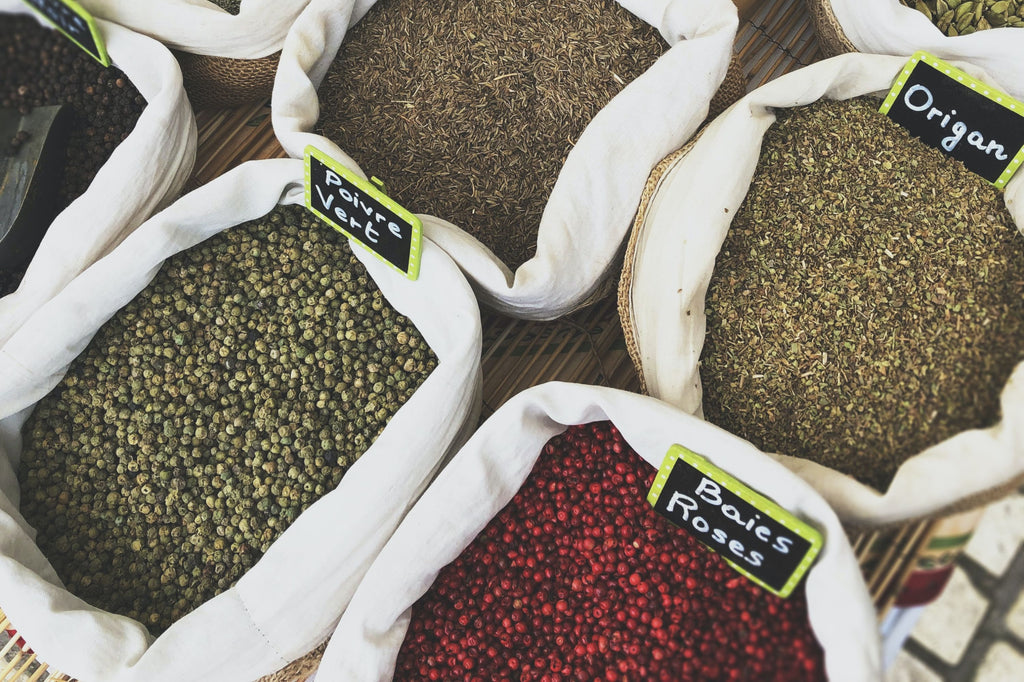I. Introduction
The kitchen is the heart of every home, but it can also be one of the places where waste is generated the most. Packaging, single-use products and food scraps all contribute to the environmental footprint of our kitchen. However, there is a solution: zero waste cooking.
In this article, we'll explore the importance of reducing waste in the kitchen and provide you with 10 practical tips for doing so. Our goal is to show you how you can transform your kitchen into an eco-friendly space while saving money and helping preserve our planet.
A. Presentation on the importance of reducing waste in the kitchen
The kitchen is one of the places where our daily environmental footprint is most evident. From plastic packaging to paper bags to food waste, we generate a considerable amount of waste. This overproduction of waste has a significant impact on the environment, contributing to pollution, deforestation and climate change.
Reducing waste in the kitchen is not only a positive action for the planet, but it's also a way to take control of your own environmental footprint. It is a concrete act that you can take every day to contribute to the preservation of our fragile ecosystem.
B. Definition of the objective of the article: to provide 10 practical tips for a zero waste kitchen
The main objective of this article is to guide you in transforming your kitchen into a zero waste space. We are going to provide you with 10 practical, easy-to-implement tips to significantly reduce the amount of waste you generate in your kitchen. From reducing packaging to creatively using leftover food, these tips will help you take a more sustainable approach to cooking.
C. Announcing the environmental and economic benefits of zero waste in the kitchen
Going zero waste in the kitchen has many benefits, both for the environment and for your wallet. By reducing waste, you contribute to the preservation of natural resources, the reduction of pollution and the fight against climate change. Additionally, by adopting zero waste practices, you can save money by reducing your purchases of disposable products and getting the most out of your food ingredients.
So, ready to discover how to make your kitchen more eco-friendly while saving money? Follow us through these 10 tips for a zero waste kitchen.

Summary
- I. Introduction
- A. Presentation of the importance of reducing waste in the kitchen.
- B. Definition of the objective of the article: to provide 10 practical tips for a zero waste kitchen.
- C. Announcement of the environmental and economic advantages of zero waste in the kitchen.
- II. Tip 1: Adopt reusable bags
- A. Explanation of the environmental impact of disposable plastic bags.
- B. Presentation of reusable bags as a sustainable alternative.
- C. Tips for incorporating reusable bags into your daily routine.
- III. Tip 2: Use glass containers
- A. Discussion of the potential dangers of plastic containers.
- B. Benefits of glass containers in terms of sustainability and food safety.
- C. Tips for organizing and storing food in glass containers.
- IV. Tip 3: Choose bulk purchases
- A. Presentation of the concept of bulk purchasing.
- B. Advantages of buying in bulk in terms of packaging reduction.
- C. Tips for Buying in Bulk Effectively.
- V. Tip 4: Avoid single-use products
- A. Identification of single-use products commonly used in cooking.
- B. Sustainable and reusable alternatives to these products.
- C. Encouragement to adopt new habits.
- VI. Tip 5: Compost your food waste
- A. Explaining the value of composting to reduce waste.
- B. How to set up a home composting system.
- C. Using compost to feed your garden.
- VII. Tip 6: Opt for eco-friendly cleaning products
- A. Awareness of harmful chemicals in traditional cleaning products.
- B. Introducing eco-friendly, home-made cleaning solutions.
- C. Tips for maintaining a clean and safe kitchen.
- VIII. Tip 7: Reduce food waste
- A. Discussion on the extent of food waste in households.
- B. Strategies for planning meals, storing food, and using leftovers.
- C. Implication of reducing food waste on the environment.
- IX. Tip 8: Prepare your meals at home
- A. Benefits of home cooking in terms of reducing packaging and waste.
- B. Simple and healthy meal ideas to prepare at home.
- C. Tips for saving time and money when cooking at home.
- X. Tip 9: Invest in energy-efficient appliances
- A. Importance of choosing energy-efficient kitchen appliances.
- B. Examples of energy efficient appliances and their benefits.
- C. How to maximize the energy efficiency of your existing appliances.
- XI. Tip 10: Educate yourself and share your knowledge
- A. The importance of awareness and education in reducing waste.
- B. Resources to learn more about zero waste in the kitchen.
- C. Encouragement to share your knowledge and inspire others.
- XII. Conclusion
- A. Summary of 10 tips for a zero waste kitchen.
- B. Call to action to start today.
- C. Commitment to a more sustainable and environmentally friendly lifestyle.

II. Tip 1: Adopt reusable bags
The first step towards a zero waste kitchen is to rethink the way we transport our groceries and purchases. Disposable plastic bags are one of the main culprits of plastic pollution in our environment. They have a significant impact on wildlife, oceans and air quality. This is why it is essential to switch to reusable bags .
A. Explanation of the environmental impact of disposable plastic bags
Disposable plastic bags are one of the most visible symbols of plastic pollution. They are made from petroleum, a non-renewable resource, and their production generates a significant amount of greenhouse gases. Once discarded, they can take hundreds of years to decompose in nature, leading to contamination of our ecosystems, oceans and rivers.
Additionally, many marine and land animals accidentally ingest plastic bags, which can lead to their death. Plastic bags are therefore a serious danger for wildlife.
B. Presentation of reusable bags as a sustainable alternative
Fortunately, there is a simple and effective alternative: reusable bags. These bags are made from sustainable materials like cotton, jute or recycled polyester. Unlike disposable plastic bags, reusable bags are built to last. They can be used hundreds of times, significantly reducing the amount of waste you produce.
Additionally, many cities and countries have implemented policies to discourage the use of disposable plastic bags by imposing taxes or banning them altogether. By switching to reusable bags, you help reduce the demand for plastic bags and encourage more sustainable practices.
C. Tips for incorporating reusable bags into your daily routine
Incorporating reusable bags into your daily routine is simple. Here are some tips to help you:
1. Keep a few folded reusable bags in your purse or car, so you always have them on hand when you run impromptu errands.
2. Make a shopping list to plan your purchases and carry enough reusable bags according to your needs.
3. Opt for reusable bags in different sizes to suit various types of items, from bulk products to larger items.
4. Encourage your family and friends to adopt reusable bags by explaining the environmental benefits.
By adopting this first tip for a zero waste kitchen, you will significantly reduce your environmental impact and contribute to the fight against plastic pollution.

III. Tip 2: Use glass containers
One of the key steps to a zero waste kitchen is to review the containers you use to store your food. Plastic containers, while convenient, pose potential dangers to your health and the environment. A safer and more sustainable alternative is to opt for glass containers.
A. Discussion of the potential dangers of plastic containers
Plastic containers are commonly used in our kitchens due to their light weight and ease of use. However, they have major drawbacks. Plastics can contain potentially harmful chemicals, such as phthalates and bisphenols, which can leach into food and cause health problems.
Additionally, plastic containers have a limited lifespan and often eventually crack, break, or become deformed. This leads to increased production of plastic waste and a constant need to replace it.
B. Benefits of glass containers in terms of sustainability and food safety
Glass containers offer a safer and more sustainable alternative. Unlike plastic, glass is non-porous and does not absorb odors or flavors from stored foods. Plus, it doesn't contain potentially harmful chemicals, ensuring your food is safe.
By using glass containers, you also reduce your environmental footprint. Glass containers are reusable and durable, meaning they can last for years. You don't have to worry about replacing them regularly like plastic containers.
C. Tips for Organizing and Storing Food in Glass Containers
To integrate glass containers into your zero waste kitchen, follow these tips:
1. Invest in a variety of different sized glass containers to suit your storage needs.
2. Use glass containers to store leftovers, bulk produce, snacks and even pre-prepared meals.
3. Label glass containers for easy organization and to avoid food waste.
4. When reheating food, remove the glass lid to avoid possible breakage in the microwave oven.
By adopting this tip, you will be taking an important step towards a zero waste kitchen while ensuring the safety of your family and the durability of your containers.

IV. Tip 3: Choose bulk purchases
Another crucial step towards a zero-waste kitchen is to rethink how you shop for food. Buying in bulk is an approach that can significantly reduce the amount of unnecessary packaging you bring into your home. In this tip, we'll explore the concept of buying in bulk, its benefits in terms of reducing packaging, and give you tips for buying in bulk efficiently.
A. Presentation of the concept of bulk purchasing
Bulk buying involves purchasing food and household products without or with minimal packaging. Instead of buying prepackaged foods in boxes, bags, or plastic bottles, you can fill your own reusable containers with the exact amount you need. This means less packaging waste ending up in the trash.
Many bulk stores offer a wide range of products, from grains to legumes to cleaning products, all available in bulk. Buying in bulk gives you full control over the quantity you buy, reducing food waste.
B. Advantages of bulk purchasing in terms of packaging reduction
One of the most obvious benefits of buying in bulk is the significant reduction in packaging. Bulk products are often offered in reusable bins or bulk dispensers, eliminating the need for individual packaging. By opting for this approach, you directly contribute to the reduction of plastic waste and the carbon footprint linked to the production of packaging.
Plus, buying in bulk can save you money by avoiding paying for expensive product packaging. You only pay for the product itself, which can be more economical in the long run.
C. Tips for Buying in Bulk Effectively
To effectively integrate bulk purchasing into your zero waste kitchen , here are some tips:
1. Bring your own reusable containers, such as glass jars, cotton bags, or metal boxes, when bulk shopping.
2. Familiarize yourself with local bulk stores and their reusable container policies.
3. Plan your shopping list in advance to avoid overbuying.
4. Opt for bulk products with a long shelf life to reduce the risk of food waste.
By choosing to buy in bulk, you will significantly reduce the amount of plastic waste you generate in your kitchen, while promoting more conscious and responsible consumption.

V. Tip 4: Avoid single-use products
One of the keys to a zero waste kitchen is to identify and reduce the use of single-use products. These products, such as paper towels, disposable plastic cutlery and individual packaging, generate a significant amount of waste. In this tip, we will identify single-use products commonly used in the kitchen, offer sustainable and reusable alternatives, and encourage the adoption of new habits.
A. Identification of single-use products commonly used in cooking
Single-use products are often integrated into our kitchen without us thinking about it. Here are some common examples:
1. Paper Towels: Used to clean spills and surfaces, they are thrown away after a single use.
2. Disposable plastic cutlery: Often used for take-out meals or picnics, they are thrown away after use.
3. Individual packaging: Many food products are individually packaged, thereby generating unnecessary waste.
4. Plastic sponge: Most kitchen sponges are made from non-recycled plastic.
B. Sustainable and reusable alternatives to these products
Fortunately, there are many sustainable and reusable alternatives to single-use products. Here are some examples :
1. Reusable paper towels: Opt for cloth napkins that you can wash and reuse instead of paper towels.
2. Stainless steel or bamboo cutlery: Invest in reusable cutlery that you can take with you to avoid using disposable plastic cutlery.
3. Reusable food packaging : Use reusable food packaging, such as waxed cloth bags, to avoid individual packaging.
4. Natural loofah sponge or reusable dishwashing brush : Natural and 100% biodegradable alternatives exist and effectively replace traditional sponges.
C. Encouragement to adopt new habits
Switching from single-use products to sustainable alternatives may require a change in mindset and behavior, but it's worth it. By adopting new habits, you will significantly reduce the amount of waste generated by your kitchen.
1. Keep your reusable paper towels handy and get used to using them to clean surfaces and spills.
2. Store reusable cutlery in your bag or car so you don't have to use disposable cutlery when dining out.
3. When shopping, choose bulk products or family sizes to reduce individual packaging.
By following these tips, you will help significantly reduce your kitchen waste and lead a more eco-friendly lifestyle.

VI. Tip 5: Compost your food waste
Another important tip for reducing your environmental footprint in the kitchen is to set up a composting system for your food waste. Composting is an effective method for reducing organic waste and producing natural fertilizer for your garden. In this tip, we'll explain the value of composting, how to set up a home composting system, and how to use compost to feed your garden.
A. Explaining the value of composting to reduce waste
Composting is an essential strategy for reducing the amount of food waste sent to landfill. When food waste decomposes in landfills, it produces methane, a potent greenhouse gas that contributes to climate change. By composting your food waste, you divert it from landfill and help reduce greenhouse gas emissions.
Additionally, compost produced from your food waste can be used as a natural fertilizer for your garden, improving soil quality and promoting plant growth.
B. How to set up a home composting system
To set up a home composting system, follow these steps:
1. Get a composting bin: You can purchase a composting bin from a garden store or make one yourself from recycled materials.
2. Collect food waste: Collect food waste such as fruit and vegetable scraps, egg shells, coffee grounds, and dead leaves.
3. Alternate layers: Add layers of food waste to your compost bin, alternating with layers of brown materials such as fallen leaves, wood chips or newspaper.
4. Aerate and mix: Regularly aerate the compost using a composting fork and mix the layers to encourage decomposition.
C. Using Compost to Feed Your Garden
Once your compost is ready, you can use it to enrich your garden. Compost is rich in essential plant nutrients, which improves soil health and promotes the growth of vegetables, flowers and trees.
Spread a layer of compost over your garden or mix it with existing soil. You can also use compost to feed your potted plants. Composting your food waste thus becomes a practical and beneficial way to reduce your environmental footprint while promoting the fertility of your garden.
By adopting this tip, you will help reduce the amount of food waste sent to landfill, reduce greenhouse gas emissions and improve the health of your garden.

VII. Tip 6: Opt for eco-friendly cleaning products
A zero waste kitchen is not just about managing food waste, but also using eco-friendly cleaning products. In this tip, we'll raise awareness about harmful chemicals found in traditional cleaning products, introduce eco-friendly and DIY cleaning solutions , and provide tips for maintaining a clean and safe kitchen.
A. Awareness of harmful chemicals in traditional cleaning products
Traditional cleaning products often contain a multitude of chemicals that are harmful to human health and the environment. These chemicals can leave residue on your kitchen surfaces, be inhaled during cleaning, or contaminate water when flushed. Common chemicals found in traditional cleaning products include parabens, phthalates, quaternary ammoniums, and volatile organic compounds (VOCs).
The use of these products can have harmful consequences on the indoor air quality of your home and on the environment. Additionally, they may pose health risks, especially for children and people sensitive to allergies.
B. Introducing eco-friendly, home-made cleaning solutions
To avoid harmful chemicals, opt for eco-friendly, homemade cleaning solutions. You can make your own cleaning products using simple, non-toxic ingredients such as white vinegar, baking soda, lemon and essential oil.
Here are some examples of ecological cleaning products:
1. Vinegar Multi-Purpose Cleaner: Mix one part white vinegar with two parts water in a spray bottle. Add a few drops of essential oil for a pleasant scent.
2. Baking Soda Degreaser: Sprinkle baking soda on greasy surfaces, add a little water and scrub to remove dirt.
3. Lemon Window Cleaner: Mix fresh lemon juice with water in a spray bottle to clean glass surfaces.
C. Tips for Maintaining a Clean and Safe Kitchen
To maintain a clean and safe kitchen while switching to eco-friendly cleaning products, follow these tips:
1. Clean regularly: Establish a regular cleaning schedule to prevent dirt buildup.
2. Avoid disposables: Use reusable cloths rather than disposable wipes for cleaning.
3. Store safely: Store cleaning products out of the reach of children and in properly labeled containers.
By opting for eco-friendly cleaning products, you maintain a clean kitchen while reducing your environmental impact and creating a healthier environment for your family.

VIII. Tip 7: Reduce food waste
Food waste is a major problem in many households, contributing to both loss of resources and increased waste. In this tip, we'll discuss the extent of food waste , offer strategies for planning meals, storing food, and using leftovers efficiently, and explaining how reducing food waste has a positive impact on the environment .
A. Discussion on the extent of food waste in households
Food waste is more common in our kitchens than we think. From fruits and vegetables rotting in the fridge to leftover meals ending up in the trash, homes generate a considerable amount of food waste. According to the Food and Agriculture Organization of the United Nations (FAO), approximately one third of the food produced globally is lost or wasted each year. This statistic is alarming, given the resources required for food production.
Food waste also has a significant financial impact, as families spend money on food that ends up being thrown away. It is therefore essential to take steps to reduce food waste in our kitchens.
B. Strategies for planning meals, storing food, and using leftovers
Reducing food waste starts with smart meal planning. Here are some useful strategies:
1. Meal planning: Establish a weekly menu, make a shopping list based on that menu and stick to it.
2. Proper Storage: Learn how to store food properly to extend its shelf life. Use airtight containers to avoid loss of freshness.
3. Using Leftovers: Reinvent leftovers by creating new dishes. For example, cooked vegetables can be made into soup, and leftover meat can be added to salads or sandwiches.
C. Implication of reducing food waste on the environment
Reducing food waste has a direct impact on the environment. When we throw away food, we not only waste the resources used to produce it, but we also contribute to greenhouse gas emissions. Food waste that decomposes in landfills produces methane, a greenhouse gas potentially more harmful than carbon dioxide.
By reducing food waste, we contribute to the preservation of natural resources, the reduction of greenhouse gas emissions and the fight against world hunger by efficiently using available food resources.
By following this tip, you can not only save money, but also have a positive impact on the environment by reducing food waste in your kitchen.

IX. Tip 8: Prepare your meals at home
One of the best ways to reduce your environmental footprint in the kitchen is to prepare your meals at home. In this tip, we'll explore the benefits of cooking at home in terms of reducing packaging and waste, give you ideas for simple and healthy meals to prepare at home, and share tips for saving time and money while cooking at home.
A. Benefits of home cooking in terms of reducing packaging and waste
When you prepare your meals at home, you have complete control over the ingredients you use and the packaging you will generate. Here's how home cooking helps reduce environmental impact:
1. Reduced packaging: By cooking yourself, you can purchase ingredients in bulk or large quantities, which reduces the amount of individual packaging used.
2. Waste management: By using ingredients efficiently and reusing leftovers, you reduce food waste.
3. Energy Saving: Cooking at home can be more energy efficient than eating out because you have greater control over kitchen appliances and quantities.
B. Simple and healthy meal ideas to prepare at home
Home cooking can be both healthy and delicious. Here are some simple meal ideas you can prepare at home:
1. Mixed salads: Mix fresh vegetables, proteins, legumes and whole grains to create balanced and flavorful salads.
2. Cereal Bowls: Make cereal bowls with oatmeal, fruit, nuts and yogurt for a nutritious breakfast.
3. Stew dishes: Prepare stews using vegetables, meat or vegetarian alternatives for a hearty meal.
C. Tips for saving time and money when cooking at home
Cooking at home may seem more time consuming, but with a few tips you can save time and money:
1. Meal planning: Establish a weekly meal plan and make a shopping list to avoid impulse purchases.
2. Batch Prep: Prepare meals in larger quantities and freeze extra portions for future meals.
3. Using Leftovers: Reinvent leftovers by turning them into new meals to avoid waste.
By following this tip, you will discover that cooking at home is an economical, healthy and environmentally friendly option.

X. Tip 9: Invest in energy-efficient appliances
Choosing energy-efficient kitchen appliances can have a significant impact on your environmental footprint. In this tip, we'll discuss the importance of choosing energy-efficient kitchen appliances, show examples of energy-efficient appliances and their benefits, as well as give you tips for maximizing the energy efficiency of your appliances existing.
A. Importance of choosing energy-efficient kitchen appliances
Kitchen appliances are among the biggest consumers of energy in our homes. They are used daily for cooking, refrigerating, washing and more. Therefore, choosing energy-efficient appliances is essential to reduce your energy consumption and environmental impact. Here's why this is important:
1. Reduced energy consumption: Energy-efficient appliances use less electricity or gas to operate, reducing energy demand and greenhouse gas emissions.
2. Financial Savings: Energy-efficient appliances can lower your energy bill in the long run, saving you money.
3. Sustainability: By choosing energy-efficient appliances, you contribute to the long-term sustainability of the planet by reducing pressure on energy resources.
B. Examples of energy efficient appliances and their benefits
There are many energy-efficient kitchen appliances on the market, designed to minimize their energy consumption. Here are some examples and their advantages:
1. Energy-efficient refrigerators and freezers: These appliances are well insulated and use more efficient compressors to reduce energy consumption while maintaining stable temperatures.
2. Induction Cookers: Induction cookers heat quickly and more efficiently than traditional electric cookers, reducing energy consumption.
3. Water and energy efficient dishwashers: Modern models are designed to use less water and electricity while still providing efficient cleaning.
C. How to maximize the energy efficiency of your existing appliances
If you can't invest in new energy-efficient appliances, there are ways to maximize the energy efficiency of your existing appliances:
1. Regular Maintenance: Make sure your appliances are maintained regularly to keep them running efficiently.
2. Use wisely: Use your appliances wisely, avoiding leaving them on standby and using energy-efficient cycles when possible.
3. Updates: If some parts of your appliances are worn, consider replacing them to maintain their energy efficiency.
By following this tip, you will help reduce your energy consumption in the kitchen and minimize your environmental impact.

XI. Tip 10: Educate yourself and share your knowledge
The final tip for reducing your environmental footprint in the kitchen is to educate yourself and share your knowledge with others. In this section, we'll explore the importance of awareness and education in reducing waste, provide you with resources to learn about zero waste in the kitchen, and encourage you to share your knowledge to inspire others .
A. The importance of awareness and education in reducing waste
Education plays a crucial role in the transition to a zero-waste lifestyle in the kitchen. By understanding the impact of our food choices and cooking habits, we are better equipped to make more responsible decisions. Here's why awareness and education are important:
1. Awareness: Learning about environmental issues related to food waste, packaging and energy consumption raises our awareness of these issues.
2. Motivation: Education can motivate us to make positive changes in our eating and cooking habits.
3. Informed decision making: By understanding sustainable alternatives, we can make more thoughtful food and cooking choices.
B. Resources to learn more about zero waste in the kitchen
To educate yourself further about zero waste in the kitchen, here are some useful resources:
1. Books: There are many books on zero waste and sustainable cooking. Look for books that will guide you in reducing food waste and packaging.
2. Websites and blogs: Many blogs and websites are dedicated to zero waste in the kitchen. They offer practical advice, recipes and inspiring stories.
3. Online Communities: Join online discussion groups or zero waste communities to share your experiences, ask questions and learn from others.
C. Encouragement to share your knowledge and inspire others
Once you gain knowledge about zero waste in the kitchen, don't hesitate to share it with your family, friends and community. You can :
1. Organize workshops or presentations to educate others about the benefits of zero waste in the kitchen.
2. Share your achievements and tips on social media to inspire others to adopt a more sustainable lifestyle.
3. Encourage local restaurants to adopt more environmentally friendly practices.
By sharing your knowledge and inspiring others, you help create positive change and expand the impact of the zero waste movement.

XII. Conclusion
Congratulations on going through the 10 tips for a zero waste kitchen! We hope this article has inspired you to rethink your eating and cooking habits to reduce your environmental footprint. To sum up :
A. Summary of 10 tips for a zero waste kitchen
1. Switch to reusable bags to eliminate disposable plastic bags.
2. Use glass containers instead of plastic to store your food.
3. Favor bulk purchases to reduce packaging.
4. Avoid single-use products by opting for sustainable alternatives.
5. Compost your food waste to reduce waste.
6. Opt for eco-friendly cleaning products for a cleaner, safer kitchen.
7. Reduce food waste by planning, storing and using your leftovers.
8. Prepare your meals at home to reduce packaging and waste.
9. Invest in energy-efficient appliances to reduce energy consumption.
10. Educate yourself and share your knowledge to inspire others.
B. Call to Action to Start Today
Now is the time to take action! Choose at least one of these tips and start incorporating zero waste practices into your kitchen today. Every little gesture counts and can have a positive impact on the environment.
Here are some ideas to get started:
- Get in the habit of using reusable bags when you go shopping.
- Gradually replace plastic containers with glass containers.
- Explore bulk stores in your area and purchase certain products without packaging.
- Identify single-use products you use regularly and find sustainable alternatives.
- Start a small home composter to reduce your food waste.
- Look for eco-friendly cleaning products or make your own from natural ingredients.
- Plan your meals, use your leftovers and try to reduce food waste.
- Prepare a delicious homemade meal and invite friends or relatives to share it.
- Educate yourself more about zero waste by reading books, following blogs, or joining discussion groups.
C. Commitment to a more sustainable and environmentally friendly lifestyle
By adopting these tips for a zero waste kitchen, you are committing to reducing your environmental footprint and contributing to a more sustainable future for our planet. Every little bit counts, and together we can create positive change. Continue to explore new ways to live more environmentally friendly and inspire others to do the same. Thank you for being an agent of change for a cleaner, greener world!
We encourage you to share this article with your loved ones and invite them to join the zero waste movement in the kitchen. Together we can make a significant difference.


